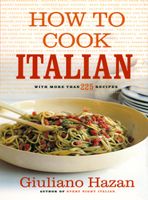Advertisement
Cookware
Appears in
Published 2005
Your pots and pans should conduct heat to food evenly throughout the pan. Since Italian cooking is so dependent on stovetop cooking, use pans that allow you to sauté without burning and that do not have hot spots so that a risotto can cook evenly, for example. Aluminum is an excellent conductor of heat, but it is soft and reacts to acidic foods, so the aluminum either must be encased in stainless steel, which is more scratch resistant and nonreactive to acidic foods, or it must be hard anodized. I have found hard-anodized aluminum one of the best surfaces for Italian cooking. The food makes direct contact with the conductive metal, optimizing its ability to sear food and allowing the juices to caramelize on the pan bottom. This also makes it possible to form a sauce by dissolving the “browned bits” with moisture, be it water, wine, broth, or the liquid tomatoes release. This is essential in Italian cooking because sauces are usually made simply from the cooking residues on the bottom of the pan.

